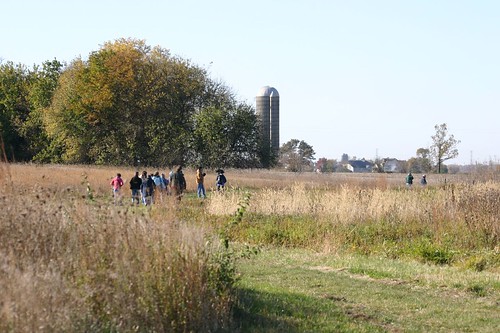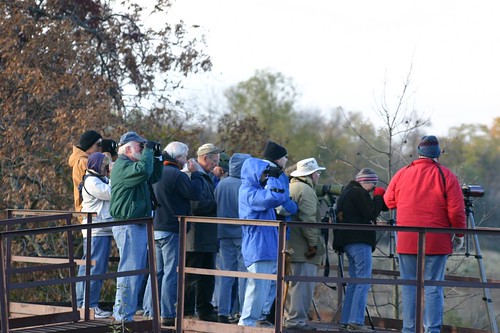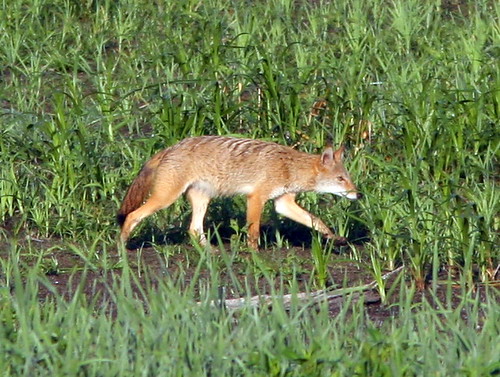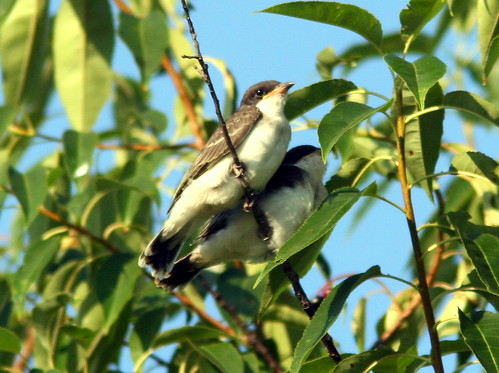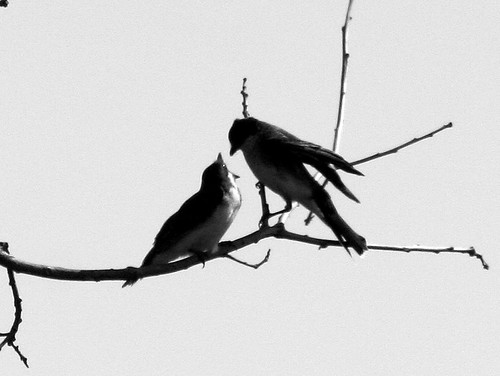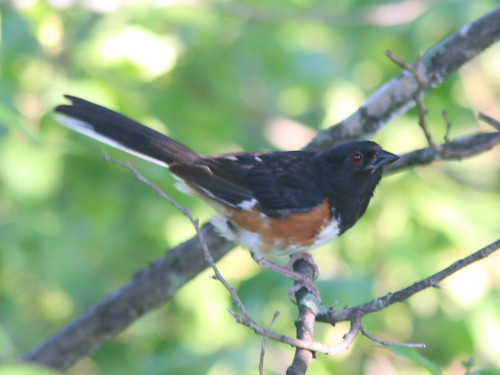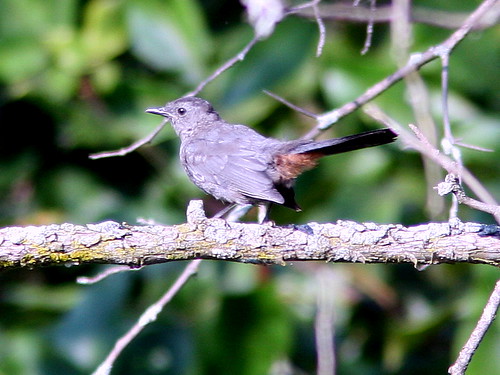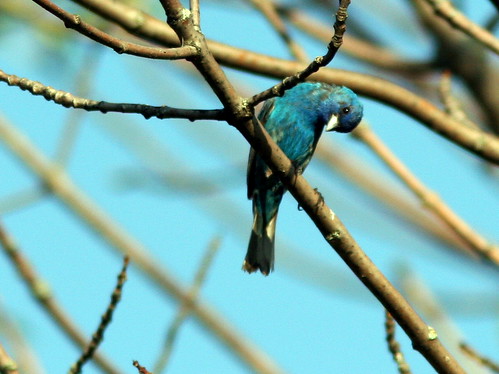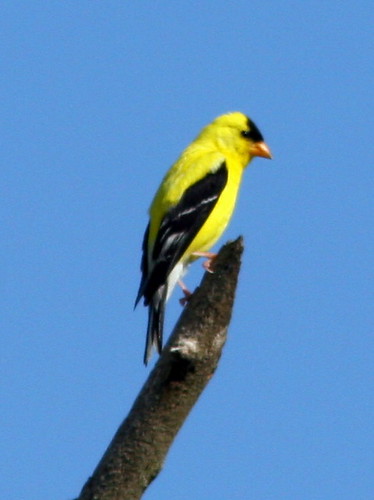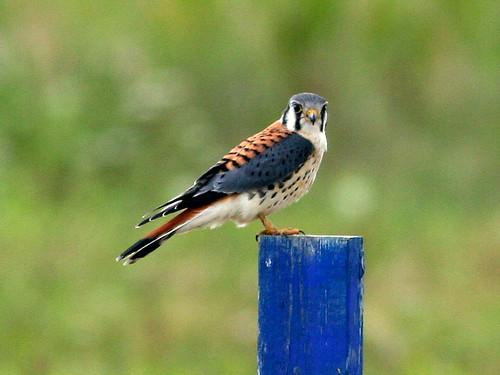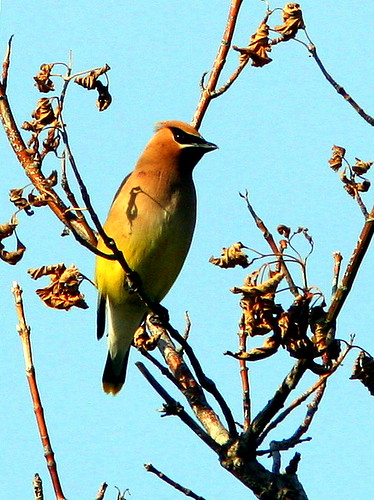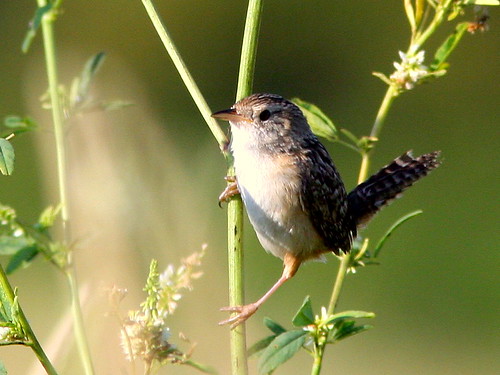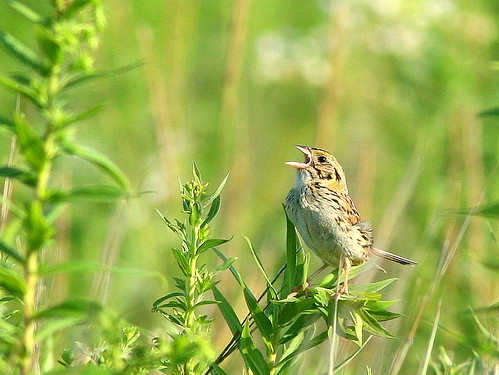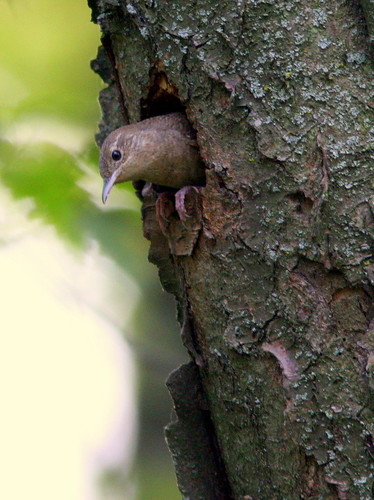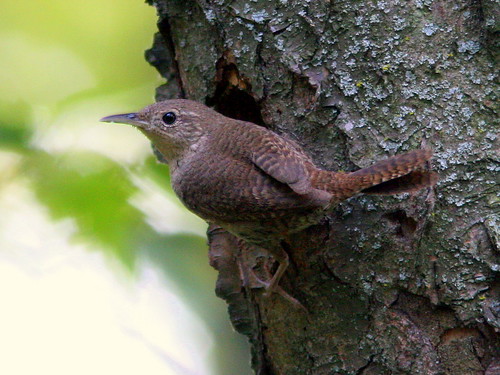Kane County Audubon Society birders on east trail at Nelson Lake:
The eastern portion of Nelson Lake/Dick Young Kane County (Illinois) Forest Preserve offers a greater variety of habitats than the newly developed northern and western part of the preserve. As noted im my previous post, the latter area is dominated by tall grass prairie. Interfaces between different habitats are usually more ecologically diverse. On the east side there are many more “edges” to explore, between the lake, wetlands, woodlands and grasslands.
Looking back towards the old silo that marks the east entry: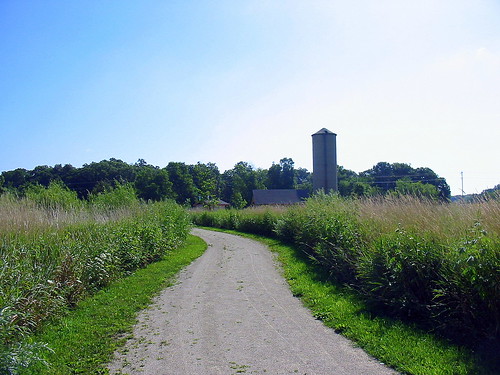
This panoramic view was taken from the entrance path, facing to the west. Directly in front is the observation platform that overlooks the lake. Extensive woodlands encircle the lake, and grasslands are on both sides, to the south and north. A 3 1/2 mile mowed path follows the lake’s perimeter.
Click for a scrolling panorama at http://clvr.eu/acc (reduce image size to better appreciate the view):
The grasslands on the east side of Nelson lake are not extensive enough to attract Bobolinks and Henslow’s Sparrows, but during spring and summer we usually hear a half dozen Sedge Wrens singing
next to the entrance path.
Four male Sedge Wrens were still singing on August 18th:
The Kane County Audubon Society sponsors 8:00 AM field trips on the first Saturday of each month. In November, the general public is invited to participate in “scope day,” when members bring their spotting scopes and array them on the metal deck, where the lake and wetlands may be conveniently scanned.
Scope Day, back in November, 2007:
Last week, we arrived at the observation deck early, and saw this Coyote hunting along the shore of Nelson Lake:
As we watched the Coyote, a Ruby-throated Hummingbird perched right next to us, so close that I had to switch to a macro lens setting: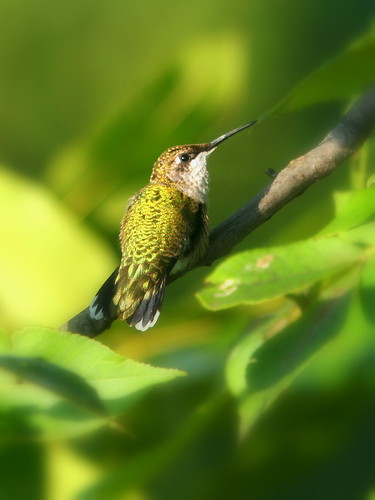
A family of Eastern Kingbird fledglings waited patiently to be fed:
A parent bird arrived with a fairly large wild cherry, but the adult had to eat it after the begging youngsters repeatedly refused to swallow it: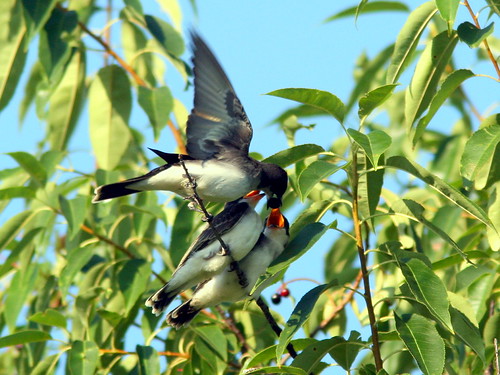
Backlighted by the low sun, a third chick readily accepted an insect treat:
A red-eyed Eastern Towhee scolded us from a nearby bush:
A Brown Thrasher glared at us with white eyes:
A Gray Catbird showed us its reddish under-tail coverts:
A molting Indigo bunting craned his neck, as if to get a better look at us:
This Common Yellowthroat also cocked his head quizzically: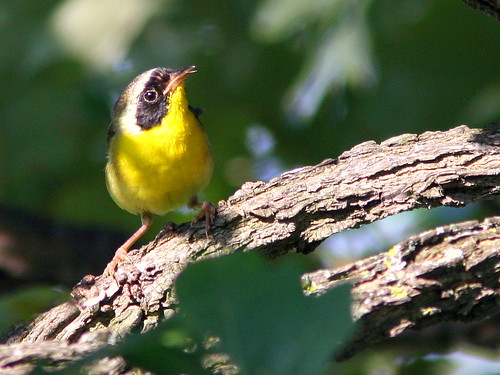
A fledgling yellowthroat was nearby, atop a milkweed: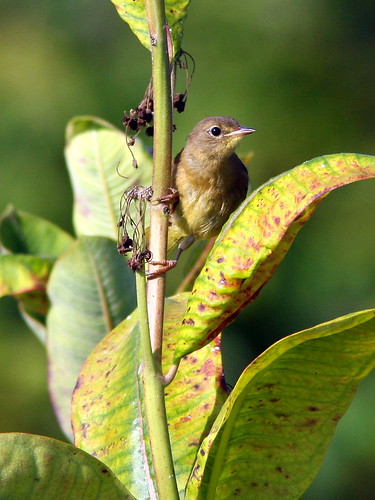
It is hard to turn down an American Goldfinch photo opportunity:
Many birds were molting, such as this shaggy Red-tailed Hawk; note the symmetry of flight feather replacement that maintains flight balance: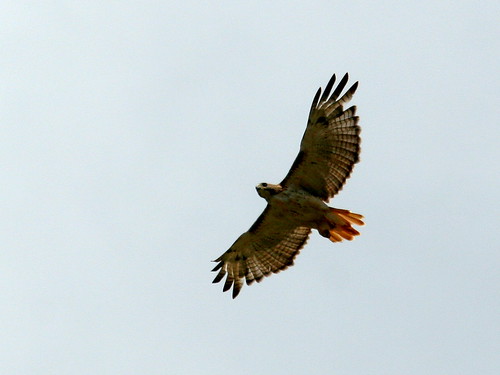
Back at our condo, a male American Kestrel hunting for grasshoppers posed on a painted post just outside our front door, but his mate was out of camera range:
Happily, an expansive area of protected prairie is only a couple of miles from our summer home in northern Illinois. Kane County’s Nelson Lake/Dick Young Marsh and Forest Preserve deserves to be renamed. Both the wooded areas and the lake with its surrounding wetlands harbor a great diversity of bird species at all seasons, but thanks to recent acquisitions, grasslands now predominate. Local resident Christopher Cudworth’s recent blog provides a bit of the history and feel of this marvelous place. It’s no surprise that Nelson Lake is at the top of our list of accessible birding “patches”
Perhaps as a result of growing up among tightly spaced three story frame houses in suburban New Jersey, I especially enjoy open views that allow my eyes to simply relax, and appreciate why the ancient people of the deserts believed that the earth is flat. The prairie provides such vistas, as do the mountains and the seashore, all favorite places of mine.
On morning walks at Nelson Lake, Mary Lou and I have tuned into the rhythm of the cycling seasons, the ever-changing backdrop of flowers and activities of the birds we love to watch. Presently, with the dog days of summer, we see a winding down of nesting activity. Young birds abound.
Some youngsters can present identification challenges, as was the case with this swallow that was associating with a flock of fledgling Tree Swallows. Its brown back and the yellow edges of its gape established that it was also newly fledged, but its breast was smudged with brown that almost formed a distinct horizontal band. Its clear throat seemed to rule out a Northern Rough-winged Swallow.
The strong demarcation between its dark cap and the lower half of its head were entirely consistent with a Tree Swallow: 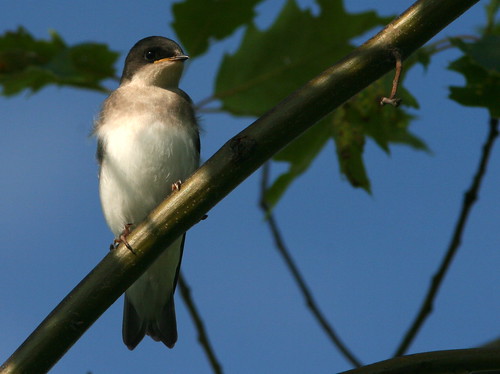
Then, also congregating with the Tree Swallows that were waiting to be fed, we saw this brown-backed bird. Its horizontal breast band was much more distinct, and the dark area extended partially down the midline of its belly. Further, its white collar blended more softly with the color of its cap, and extended around the sides of its head and curled up behind its dark ear patch. It lacked a yellow gape, suggesting it had not just recently left the nest. Its eyes were remarkably large and almost doleful.
This bird was, indeed, a Bank Swallow (click on image to see comparisons with fledgling Tree Swallows):
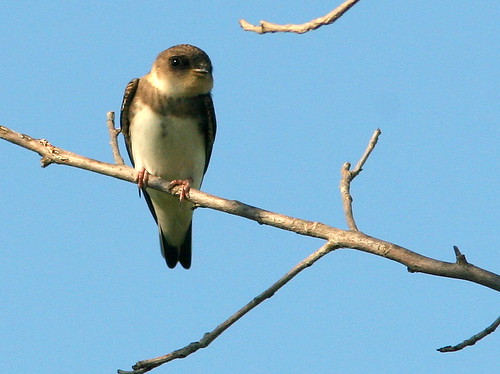
Either of these swallows, when flying by at a fast clip would have presented real identification challenges. Bank Swallows create nesting cavities by burrowing into the sides of cliffs. As a child I remember seeing colonial nesting sites of Bank Swallows along the banks of the Passaic River. In Illinois, they often utilize the sides of man-made cuts, such as gravel quarries and even piles of topsoil that developers remove from construction sites.
Without the aid of binoculars, these two youngsters could appear rather non-descript:
A distinctively plumaged adult Cedar Waxwing joined them:
Eastern Kingbirds were rarely seen near our central New Mexico mountain home, and in South Florida they may be brief migratory transients. This one was a welcome sight as it kept watch from the edge of a patch of woodlands: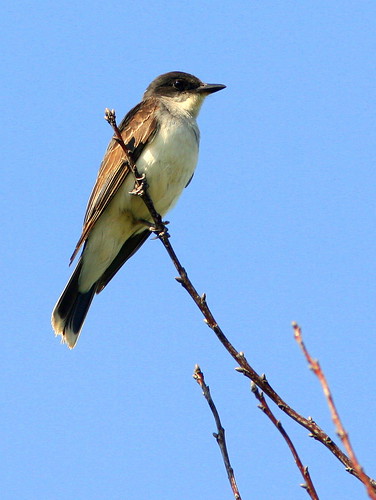
Earlier this week, Sedge Wrens were still singing and bringing food to their broods:
After missing them for a few days, Henslow’s Sparrows seemed to have reappeared, and we heard two of them singing along the trail through an area of prairie that had escaped a recent prescribed burn.
By sheer luck, I happened to click the shutter just as this one uttered its quarter-second song:
Sunflowers and a female American Goldfinch provided a pleasant arrangement: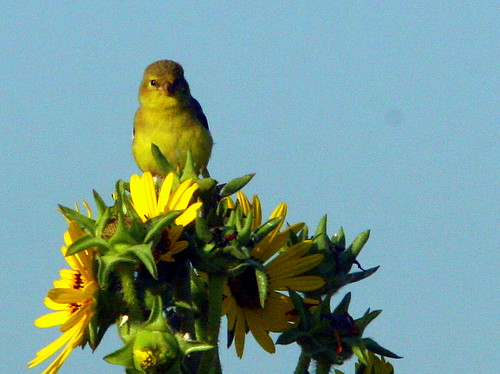
A reclusive female Common Yellowthroat put in a brief appearance: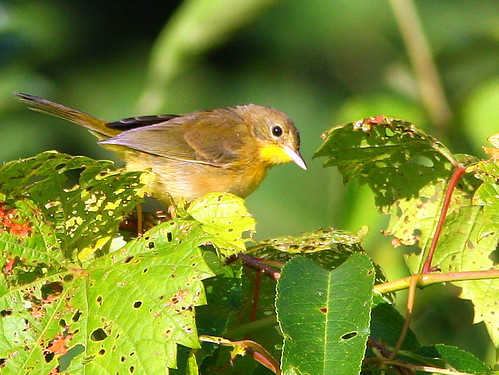
An Eastern Towhee flashed its red eyes and “Chewinked’ at us from the safety of a tangle of dead branches: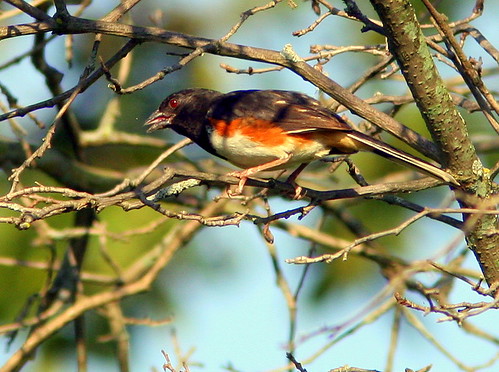
Luckily, I reached for my camera instead of my binoculars when I recognized the call and profile of this Hairy Woodpecker as it alighted for a few seconds and then promptly disappeared. When serving as an interpreter at Rio Grande Nature Center, I reminded bird watchers of two features that distinguish this species from the smaller but similar Downy Woodpecker. The Hairy “Haint” got no black spots on its outer tail feathers, and (arrgh!) if you push a Hairy Woodpecker’s bill into its face it will almost stick out the back of its head.
This Hairy Woodpecker, even when photographed at a distance, clearly shows both features: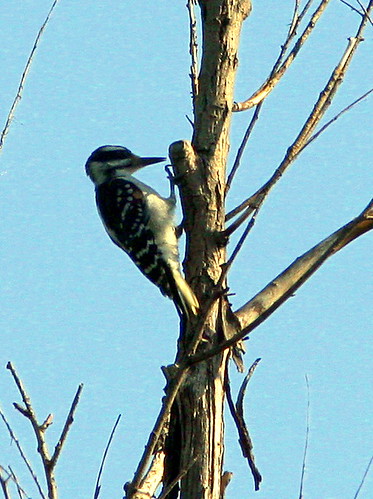
“A weed is a beautiful creation of nature that is just in the wrong place.” This aphorism is nicely illustrated by this noxious and invasive Hibiscus trionum “Flower-of-an-Hour,” so called because its flowers appear, oh so briefly (Its popular but much larger relative, the Rose of Sharon, Hibiscus syriacs, likewise can spread out of control):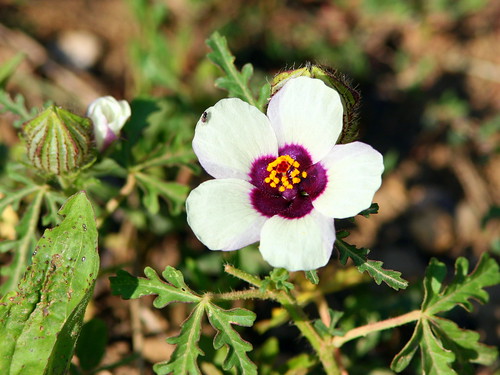
“M&Ms:” Monarchs and Milkweed go together:
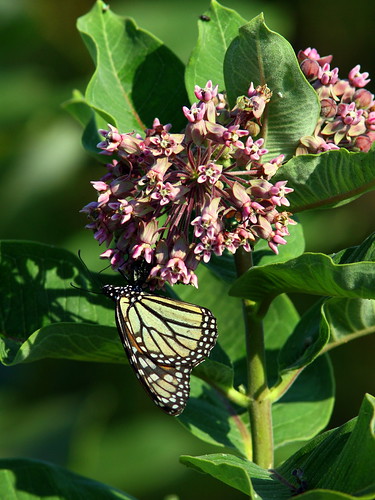
While walking our daughter’s dog in nearby Hawk’s Bluff Park, we encountered a pair of House Wrens busily gathering insects for their chicks:













